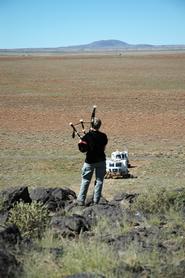
In September, NASA’s next-generation prototype lunar rovers roamed the San Francisco Volcanic Field north of Flagstaff, Az., as part of NASA’s 2010 Desert RATS (Research and Technology Studies) project. One of the aims of the mission was to conduct two weeks of geologic field work simulating lunar operations in order to test various data collection and communications scenarios. Professor of Geosciences Barbara Tewksbury was part of the Science Team “back room” that supported the field work and evaluated the science that the astronauts in the rovers were doing.
Over the course of the test Tewksbury had several jobs. She ran the imaging acquisition and documentation systems for the rover traverses and crew EVAs (extravehicular activities - i.e., simulations of space walks), and she spent several night shifts on the Strategic Science Team, which evaluated data and planned the next day’s work. On the last day of the test, she was in charge of sample documentation for the sample analysis simulation. Tewksbury also had the extraordinary experience of playing her bagpipes to pipe the rovers back to Base Camp after their week out in the field.
The rovers are remarkable vehicles that allow two astronauts to live, eat, sleep and travel in a shirtsleeve environment and to quickly don space suits for EVAs. The vehicles are about the size of a small motor home and have been affectionately referred to as “Lunabagos.” The NASA Desert RATS web page has photos of both the rovers and the test.
NASA did a live interview with Tewksbury for NASA TV, and the interview is folded into a half hour program that's viewable on the web. Her interview starts at about 17:40 into the program.
When the project concluded, Tewksbury said, “The whole experience was one of the most extraordinary of my entire life. The people involved were truly remarkable, from the astronauts to the communications people to the folks who kept the rovers running to the geologists in the back room and in the field. Every single person was totally committed to the test and completely passionate about doing the best possible job.”
